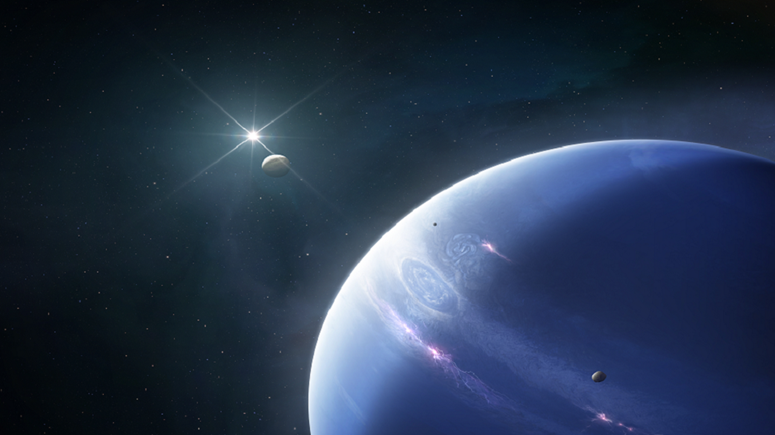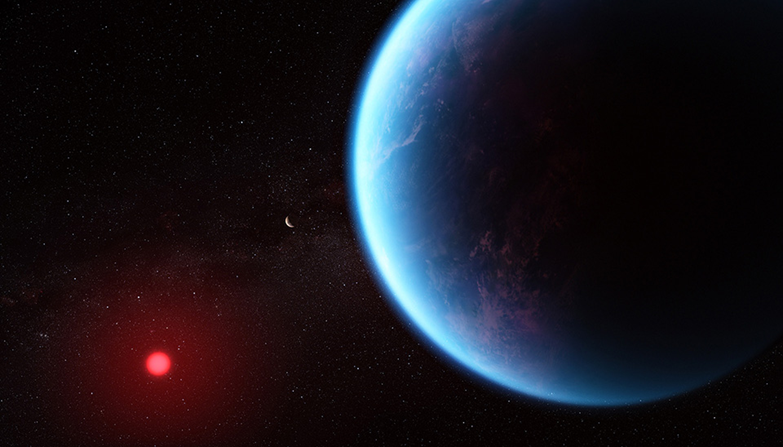James Webb discovers a distant exoplanet that could contain a possible trace of life

Scientists at NASA have announced the presence of a possible rare water ocean on a giant exoplanet dozens of light-years away, as well as a chemical trace of a sign of possible life.
Scientists made this “interesting” discovery using the US Space Agency’s James Webb Telescope, which looks 120 light-years from Earth in the constellation Leo, based on previous studies of the region using the James Webb, Hubble, and Kepler telescopes.
Scientists named the exoplanet K2-18 b. NASA says that the mass of this planet is approximately nine times the mass of Earth.
Scientists said that the James Webb Telescope was able to discover a molecule called dimethyl sulfide (or DMS), which is produced on Earth only by life. Most of it comes from phytoplankton in marine environments.
Scientists have not yet confirmed this observation, and it needs further verification. Additional research should confirm whether dimethyl sulfide is indeed present in the remote plant in significant quantities.
Scientists point out that K2-18 b has proven to be interesting for other reasons, as the planet contains carbon-bearing molecules, including methane and carbon dioxide, which in itself is a major discovery for the search for life.
Scientists say that K2-18 b is a planet with a hydrogen-rich atmosphere and a surface covered in water. Both conditions are believed to be conducive to any possible alien life.
“K2-18 b is a Hycean exoplanet, one that has the potential to have a hydrogen-rich atmosphere and a surface covered by a water ocean.”
K2-18 b orbits a cool dwarf star known as K2-18, and together they are located about 120 light-years from Earth.

The planet's mass is 8.6 times the mass of Earth. Scientists refer to such planets as “sub-Neptune planets,” and there is nothing like them in our solar system, which means they are relatively unknown to scientists.
Scientists do not know, for example, what the atmospheres might look like on such worlds. But the new findings suggest it could be a fruitful place to search for alien life.
“Our findings underscore the importance of considering diverse habitable environments when searching for life elsewhere,” explained Nico Madhusudan, an astronomer at the University of Cambridge and lead author of the new paper. “Traditionally, the search for life on exoplanets has focused primarily on smaller, rocky planets, but larger Hycean worlds are more suitable for atmospheric observations.”
There may still be conditions that make K2-18 b difficult for life. It is thought to have an oceanic surface, but this ocean may be too hot to live in, and may not be liquid at all.

Scientists hope to learn more about the planet as well as other sub-planets through further observations. But it may be difficult to see - Although they are the most common type of planet known in the galaxy - they are often covered by the glow emanating from their stars.
K2-18 b was observed for the first time using this glow, observing the dip in light that occurs when the planet moves in front of its star.
The new results used the same process, with scientists examining starlight using the James Webb Telescope and looking for traces left by chemicals in the atmosphere.
Team member Savvas Constantinou from the University of Cambridge explained: “These results are the result of just two observations of K2-18 b, and there are more on the way. "This means that our work here is only an early demonstration of what James Webb might observe in exoplanets in the habitable zone."
More work should give a better picture of these chemicals, It helps confirm the possible presence of dimethyl sulfide.
Professor Madhusudan said: “Our ultimate goal is to identify life on a habitable exoplanet, which would change our understanding of our place in the universe. “Our findings are a promising step toward a deeper understanding of the Hycean worlds in this endeavor.”
The results of the study were published in The Astrophysical Journal Letters.
Source: websites

